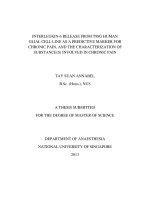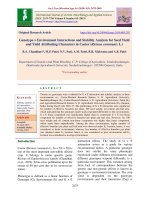The characterization of Castor (Ricinus communis L.) genotypes for morphological traits
Bạn đang xem bản rút gọn của tài liệu. Xem và tải ngay bản đầy đủ của tài liệu tại đây (1.11 MB, 11 trang )
Int.J.Curr.Microbiol.App.Sci (2019) 8(5): 2482-2492
International Journal of Current Microbiology and Applied Sciences
ISSN: 2319-7706 Volume 8 Number 05 (2019)
Journal homepage:
Original Research Article
/>
The Characterization of Castor (Ricinus communis L.) Genotypes for
Morphological Traits
B.A. Chaudhari*, M.P. Patel, J.A. Patel, R.R. Makwana, A.M. Patel and M.K. Patel
Department of Genetics and Plant breeding, C. P. College of Agriculture, Sardarkrushinagar
Dantiwada Agricultural University, Sardarkrushinagar – 385506 (Gujarat), India
*Corresponding author
ABSTRACT
Keywords
Castor,
Morphological traits
(Qualitative
characters)
Article Info
Accepted:
26 April 2019
Available Online:
10 May 2019
Twenty six genotypes were characterized based on their morphological characters as per
DUS guidelines of castor viz., stem color, bloom, seed shape, plant type, leaf shape, type
of internode, spike type, inflorescence spike type, seed coat color, branching habits, spike
shape and capsule type. The characters triple bloom nature, medium plant type, elongated
internode, conical spike shape, divergent branching pattern and oval seed shape were
dominant in nature whereas, spike types, stem colour, capsule type, type of internode,
inflorescence spike type showed more than one class of F1's from all the cross
combinations, which indicated involvement of more than one gene and epistatic type of
gene interaction for the inheritance of the character and expression of the character was
also influenced by different genetic background of parents. The germplasm has shown
great extent of morphological variability for all the traits observed.
Introduction
Castor (Ricinus communis L. 2n = 2X = 20)
resides to mono specific genus Ricinus of
Euphorbiaceae family and one of the most
important non-edible oilseed crop (Chaudhari
et al., 2019). It has cross pollination up to the
extent of 50 per cent due to its monoecious
nature.
Morphological characters like stem color,
bloom, seed shape, plant type, leaf shape,
types of internodes, spike shape, inflorescence
spike shape, seed coat color, branching habits,
spike types and capsule type are important
markers used for distinctness, uniformity and
stability (DUS) tests in castor under different
environments (Lavanya and Gopinath, 2008).
Morphological characterization of seed,
seedling and plant would generally be
considered
for
varietal
identification.
Introduction of Plant Variety Protection under
General Agreement on Trade and Tariff
(GATT) necessitated the need is precise
genotypic
characterization
with
clear
Distinctiveness (D), Uniformity (U) and
Stability (S). The concept of DUS was
fundamental for the characterization of the
variety as a unique creation. It is essential to
2482
Int.J.Curr.Microbiol.App.Sci (2019) 8(5): 2482-2492
secure Plant Breeder's Rights (PBR’s) and it
also generates official description of a variety.
Information on DUS characters generated in
castor is not documented until now. Hence,
there is a need to characterize castor
genotypes.
Materials and Methods
The main objective of the investigation was to
characterize the castor germplasm to assess
their potential to contribute to future crop
improvement programmes. The twenty six
castor genotypes including advanced parental
lines and hybrids were evaluated at CastorMustard Research Station, Sardarkrushinagar
Dantiwada
Agricultural
University,
Sardarkrushinagar in Randomized Block
Design in three replications with inter and
intra row spacing of 120 x 60 cm. Need based
agronomic and plant protection measures
were taken up for good crop growth. Data was
collected at various growth stages of castor
plant.
Results and Discussion
Three types of stem colors were observed viz.,
green, mahogany and red. Five genotypes and
three hybrids had green stem color, while
fifteen (7 genotypes + 8 hybrids) had
mahogany stem colour, remaining three
genotypes had red stem color (Table 1).
Bloom or waxy coating in castor is an
important morphological marker and serves as
a natural protection against drought, cold,
jassids etc., (Lavanya and Gopinath, 2008).
Based on presence of bloom on combination
of plant parts, genotypes in castor were
usually classified as single bloom (stem +
petiole + capsule stalks), double bloom (stem
+ petiole + capsule + lower side of the leaf)
and triple bloom (all the above parts + upper
side of the leaf).The sixteen genotypes (7
genotypes + 9 hybrids) had triple bloom
while, nine genotypes (7 genotypes + 2
hybrids) had double bloom and JI-65 had zero
bloom. Seven hybrids and twelve genotypes
had spiny capsule, while four had semi spiny
and GEETA, 48-1 and SKI-215 had non
spiny. Out of 26 genotypes, 23 genotypes had
elongated type of internodes, whereas three
genotypes had condensed type of internodes.
Three types of leaf shape, flat, semi-deep and
deep-cup were observed. Twenty three
genotypes had flat leaf shaped, remaining two
genotypes viz., VP-1 and SKP-84 had deepcup leaf shaped and GCH-7 had semi-deep
leaf shaped.
In spike shape all the twenty-six genotypes
had conical spike shape. Four types of spike
were observed like loose, semi-loose, semicompact and compact. Genotypes, GNCH-1,
GEETA, 48-1 and JI-96 had loose type spike
whereas; seven genotypes had semi-loose
spike and five genotypes had semi-compact of
spike whereas, ten genotypes had compact
spike type. In branching habit, out of 26
genotypes, 24 genotypes had divergent
branching habit while, VP-1 and SKP-84 had
convergent branching habit. Three types of
inflorescence
spike
were
observed;
monoecious, interspersed and pistillate. Out
of 26 genotypes nineteen genotypes had
interspersed inflorescence spike, while
GAUCH-1, JI-96 and VI-9 had monoecious
inflorescence
spike.
Remaining
four
genotypes viz., VP-1, GEETA, SKP-84 and
JP-65 had pistillate types of inflorescence.
The photographs of all the qualitative
characters have been shown in the figure 1-4.
Twenty six genotypes were categorized in to
three different groups as: dwarf plant type
viz., (VP-1 and SKP-84), medium plant type
(viz., GAUCH-1, GCH-2, GCH-4, GCH-6,
GCH-7, SHB-1005, SHB-1018, SHB-1019,
SHB-1029, GNCH-1, JP-65, VI-9, SKI-352,
SKI-370, SKI-372, SKI-373, DCS-94) and
tall plant type (GCH-5, GEETA, JI-35, 48-1,
SH-72, JI-96 and SKI-215). In seed shape 24
2483
Int.J.Curr.Microbiol.App.Sci (2019) 8(5): 2482-2492
genotypes had oval seed shape, while
genotype GEETA and JI-35 had round seed
shape. Two types of seed coat color were
observed; dark brown and light brown.
Genotypes GAUCH-1, GCH-2, GCH-4,
GCH-5, SHB-1005, SHB-1018, SHB-1019,
SHB-1029, GNCH-1, VP-1, GEETA, JP-65,
SKI-84, VI-9, JI-35, SH-72 JI-96, SKI-215,
SKI-370, SKI-373 and DCS-94 had dark
brown seed coat color and remaining
genotypes GCH-6, GCH-7, 48-1, SKI-352
and SKI-372 had light brown seed coat color.
The results are in accordance with findings of
Solanki and Joshi (2001), Lavanya and
Gopinath (2008), Bhanu (2009), Elena and
Edilyng (2009), Gourishankar et al., (2010),
Sakure et al., (2010), Gupta and Aggarwal
(2012), Rao (2014) and Rukhsar (2017) which
showed that morphological characterization
helps in identification of genotypes easily.
The pattern of expression of stem colour
indicated that mahogany stem colour was
controlled by nuclear genes and dominant in
nature over green and red. Crosses of red ×
green, green × mahogany and mahogany ×
mahogany stem color, all F1's were mahogany
whereas, in case of green × green stem color
all F1's produced green stem color, but in case
of red × mahogany, all F1's were green in
color. In most of the genotypes, mahogany
stem was observed with varying range from
green to red which could be due to different
genetic background of parental genotypes
influencing the expression of gene/s. With
regards to bloom, most of the genotypes were
triple bloom in nature, which indicated its
dominant nature. The triple bloom nature was
dominant over double bloom and zero bloom;
whereas, double bloom nature was dominant
over zero bloom.
Regarding capsule type, when the crosses
were made between spiny × non spiny, all F1's
were semi spiny. It is the indication of spiny
capsule type nature was co-dominant over
non-spiny capsule. Dwarf plant type had a
condensed internode. When condensed
parents crossed with elongated parents, all the
F1's were elongated internodes. This revealed
that elongated internodes were dominant over
condensed internodes. It was also observed
that all dwarf plants i.e. condensed internodes
had deep cup leaves and elongated internodes
had flat leave shape indicating pleiotropic
effect or tight linkage of genes governing
these two traits. The cup shaped leaf was
determined by a single recessive gene.
Crosses of deep cup × deep cup and flat × flat
cup, all F1's were deep cup and flat cup leaf,
respectively. However, deep cup × flat cup
parent produced flat cup except, cross SKP-84
× SKI-2015 (GCH-7). The results were not
sufficient to interpret; this could be because of
quasi quantitative character.
The conical × conical and cylindrical ×
cylindrical crosses produced conical and
cylindrical spike shape, respectively. The
results were not sufficient to interpret; this
could be because of quasi quantitative
character. An expression of spike type
showed more than one class of F1's from all
the genotypes, which indicated involvement
of more than one gene, and epistatic type of
gene interaction for the inheritance of the
character and expression of the character was
also influenced by different genetic
background of parents. When convergent ×
divergent parent was crossed, all the F1's
produced divergent branching habit. This
revealed that divergent branching pattern was
dominant over convergent branching pattern.
Regarding inflorescence spike types, in most
of the genotypes inflorescence spike types
nature was observed, which indicated its
dominant
nature.
The
interspersed
inflorescence spike type's nature was
dominant over monoecious and pistillate
whereas, monoecious nature was dominant
over pistillate.
2484
Int.J.Curr.Microbiol.App.Sci (2019) 8(5): 2482-2492
Table.1 Characterization of different qualitative characters of castor
Sr. No.
1
2
3
4
5
6
7
8
9
10
11
12
13
14
15
16
17
18
19
20
21
22
23
24
25
26
Genotypes
Stem color
GAUCH-1
GCH-2
GCH-4
GCH-5
GCH-6
GCH-7
SHB-1005
SHB-1018
SHB-1019
SHB-1029
GNCH-1
VP-1
GEETA
JP-65
SKP-84
VI-9
JI-35
48-1
SH-72
JI-96
SKI-215
SKI-352
SKI-370
SKI-372
SKI-373
DCS-94
1
Green
Green
Mahogany
Mahogany
Green
Mahogany
Mahogany
Mahogany
Mahogany
Mahogany
Mahogany
Green
Red
Red
Mahogany
Green
Green
Red
Green
Mahogany
Mahogany
Mahogany
Mahogany
Mahogany
Mahogany
Green
Bloom
2
Triple
Triple
Triple
Double
Double
Triple
Triple
Triple
Triple
Triple
Triple
Triple
Double
Zero
Triple
Double
Double
Double
Double
Triple
Double
Triple
Triple
Triple
Double
Triple
Capsule type
3
Spiny
Spiny
Semi-spiny
Semi-spiny
Spiny
Semi-spiny
Spiny
Semi-spiny
Spiny
Spiny
Spiny
Spiny
Non spiny
Spiny
Spiny
Spiny
Spiny
Non-spiny
Spiny
Spiny
Non-spiny
Spiny
Spiny
Spiny
Spiny
Spiny
2485
Types of
internodes
4
Elongated
Elongated
Elongated
Elongated
Elongated
Elongated
Condensed
Elongated
Elongated
Elongated
Elongated
Condensed
Elongated
Elongated
Condensed
Elongated
Elongated
Elongated
Elongated
Elongated
Elongated
Elongated
Elongated
Elongated
Elongated
Elongated
Leaf shape
5
Flat
Flat
Flat
Flat
Flat
Semi cup
Flat
Flat
Flat
Flat
Flat
Deep cup
Flat
Flat
Deep cup
Flat
Flat
Flat
Flat
Flat
Flat
Flat
Flat
Flat
Flat
Flat
Spike shape
6
Conical
Conical
Conical
Conical
Conical
Conical
Conical
Conical
Conical
Conical
Conical
Conical
Conical
Conical
Conical
Conical
Conical
Conical
Conical
Conical
Conical
Conical
Conical
Conical
Conical
Conical
Int.J.Curr.Microbiol.App.Sci (2019) 8(5): 2482-2492
Table 1 (Contd.)
Sr.
No.
Genotypes
Spike type
Branching habit
1
2
3
4
5
6
7
GAUCH-1
GCH-2
GCH-4
GCH-5
GCH-6
GCH-7
SHB-1005
7
Compact
Compact
Semi- compact
Semi-compact
Compact
Semi-compact
Semi-loose
8
Divergent
Divergent
Divergent
Divergent
Divergent
Divergent
Divergent
8
9
10
11
12
13
14
15
16
17
18
19
20
21
22
23
24
25
26
SHB-1018
SHB-1019
SHB-1029
GNCH-1
VP-1
GEETA
JP-65
SKP-84
VI-9
JI-35
48-1
SH-72
JI-96
SKI-215
SKI-352
SKI-370
SKI-372
SKI-373
DCS-94
Semi-loose
Semi-loose
Semi-loose
Loose
Compact
Loose
Compact
Semi-compact
Compact
Compact
Loose
Compact
Loose
Semi-compact
Compact
Compact
Semi-loose
Semi-loose
Semi-loose
Divergent
Divergent
Divergent
Divergent
Convergent
Divergent
Divergent
Convergent
Divergent
Divergent
Divergent
Divergent
Divergent
Divergent
Divergent
Divergent
Divergent
Divergent
Divergent
Inflorescence
spike types
9
Monoecious
Interspersed
Interspersed
Interspersed
Interspersed
Interspersed
Interspersed
Plant type
Seed shape
Seed coat color
10
Medium
Medium
Medium
Tall
Medium
Medium
Medium
11
Oval
Oval
Oval
Oval
Oval
Oval
Oval
12
Dark brown
Dark brown
Dark brown
Dark brown
Light brown
Light brown
Dark brown
Interspersed
Interspersed
Interspersed
Interspersed
Pistillate
Pistillate
Pistillate
Pistillate
Monoecious
Interspersed
Interspersed
Interspersed
Monoecious
Interspersed
Interspersed
Interspersed
Interspersed
Interspersed
Interspersed
Medium
Medium
Medium
Medium
Dwarf
Tall
Medium
Dwarf
Medium
Tall
Tall
Tall
Tall
Tall
Medium
Medium
Medium
Medium
Medium
Oval
Oval
Oval
Oval
Oval
Round
Oval
Oval
Oval
Round
Oval
Oval
Oval
Oval
Oval
Oval
Oval
Oval
Oval
Dark brown
Dark brown
Dark brown
Dark brown
Dark brown
Dark brown
Dark brown
Dark brown
Dark brown
Dark brown
Light brown
Dark brown
Dark brown
Dark brown
Light brown
Dark brown
Light brown
Dark brown
Dark brown
2486
Int.J.Curr.Microbiol.App.Sci (2019) 8(5): 2482-2492
Fig.1 Different qualitative characters of castor
2487
Int.J.Curr.Microbiol.App.Sci (2019) 8(5): 2482-2492
Fig.2 Different qualitative characters of castor
2488
Int.J.Curr.Microbiol.App.Sci (2019) 8(5): 2482-2492
Fig.3 Different qualitative characters of castor
2489
Int.J.Curr.Microbiol.App.Sci (2019) 8(5): 2482-2492
Fig.4 Different qualitative characters of castor
2490
Int.J.Curr.Microbiol.App.Sci (2019) 8(5): 2482-2492
Dwarf plant stature is desirable for pistillate
patent. Crosses between dwarf × medium
plants produced medium plant which
indicated that medium plant type was
dominant over dwarf plant type. In most of
the genotypes and hydrides oval seed shape
was observed. The results revealed that oval
seed shape was dominant over round seed
shape. Dark brown × dark brown seed color
produced all F1's with dark brown seed color
except, dark brown [JI-65 × JI-96 (GCH-6)] ×
dark brown [SKP-84 × SKI-215 (GCH-7)]
seed color produced F1's with light brown.
While in some crosses dark brown × light
brown produced dark brown viz., VP-1 × 48-1
(GCH-4), SKP-84 × SKI-352 (SHB-1005)
and SKP-84 × SKP-372 (SHB-1019). The
results were not sufficient to interpret; this
could be because of quasi quantitative
character.
In conclusion, morphological characters viz.,
stem color, bloom, seed shape, plant type, leaf
shape, types of internodes, spike shape,
inflorescence spike shape, seed coat color,
branching habits, spike types and capsule type
are
important
markers
to
varietal
identification and genuineness of variety in
castor. They are very important during the
development, maintenance and multiplication
of new varieties, parental lines and hybrids.
Hence, from of breeder point of view, study
of qualitative characters is very useful to
differentiate to various hybrids and their
parental lines.
References
Bhanu, K.U. (2009). Genetic divergence in
castor (Ricinus communis L.). M.Sc.
(Agri.) Thesis (Unpublished), submitted
to Acharya N. G. Ranga Agricultural
University
Agricultural
College,
Bapatla (Andhra Pradesh).
Chaudhari, B.A., Patel, M.P., Dharajiya, D.T.
and Tiwari, K.K. (2019). Assessment of
genetic diversity in castor (Ricinus
communis L.) using microsatellite
markers. Biosciences Biotechnology
Research Asia, 16(1): 61-69. DOI:
/>Elena, M. and Edilyng, R. (2009). Study of
the variability for racemes, fruits and
seeds in castor germplasm. Journal of
Revista Cientifica. 9 (4): 764-769.
Gourishankar, V., Rao, P.V.R. and Reddy,
A.V. (2010). Inheritance of certain
morphological characters and Fusarium
wilt resistance in castor (Ricinus
communis L). SABRAO Journal of
Breeding and Genetics. 42 (2): 57-64.
Gupta, R. and Aggarwal, S. (2012).
Variability studies in seed morphology
of castor (Ricinus communis L.)
collected from North-Eastern region of
India. Indian Journal of Plant genetic
resources. 26 (1): 82-85.
Lavanya, C. and Gopinath, V. (2008).
Inheritance studies for morphological
characters and sex expression in
pistillate lines of castor (Ricinus
communis L.). Indian Journal of
Genetics and Plant Breeding. 68 (3):
275-282.
Rao, S.M., Bhanu, U.K., Rao, S.V. and
Ahamed,
L.M.
(2014).
The
characterization of castor (Ricinus
communis
L.)
germplasm
for
morphological traits. International
Journal of Development Research. 4
(5): 1125-1128.
Rukhsar, S., Patel, M.P., Parmar, D.J., Kalola,
A.D.
and
Kumar,
S.
(2017).
Morphological and molecular diversity
patterns
in
castor
germplasm
accessions. Industrial Crops and
Products. 97: 316-323.
Sakure, A.A., Dhaduk, H.L., Mehta, D.R.,
Kavani, R.H. and Madariya, R.B.
(2010). Genetics diversity analysis
among castor (Ricinus communis L.)
genotypes using morphological marker.
2491
Int.J.Curr.Microbiol.App.Sci (2019) 8(5): 2482-2492
Crop Improvement. 37 (2): 99-104.
Solanki, S.S. and Joshi, P. (2001). Inheritance
study of some morphological traits in
castor (Ricinus communis L.). The
Indian Journal of Genetics and Plant
Breeding. 61 (2): 136-139.
How to cite this article:
Chaudhari, B.A., M.P. Patel, J.A. Patel, R.R. Makwana, A.M. Patel and Patel, M.K. 2019. The
Characterization of Castor (Ricinus communis L.) Genotypes for Morphological Traits.
Int.J.Curr.Microbiol.App.Sci. 8(05): 2482-2492. doi: />
2492









